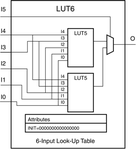exceeder88
Newbie level 2
Hi, im new to verilog. im trying to understand a code provided by xilink to create a multiplexer. the code is as follows:
the ".I0" part, what kind of operator is that? didnt find any reference to "dot" operator.
Code:
LUT6 #(
.INIT (64'h0000000F003355FF))
selection0_lut(
.I0 (data_in[0]),
.I1 (data_in[1]),
.I2 (data_in[2]),
.I3 (sel[0]),
.I4 (sel[1]),
.I5 (sel[2]),
.O (muxcy_sel[0]));the ".I0" part, what kind of operator is that? didnt find any reference to "dot" operator.
